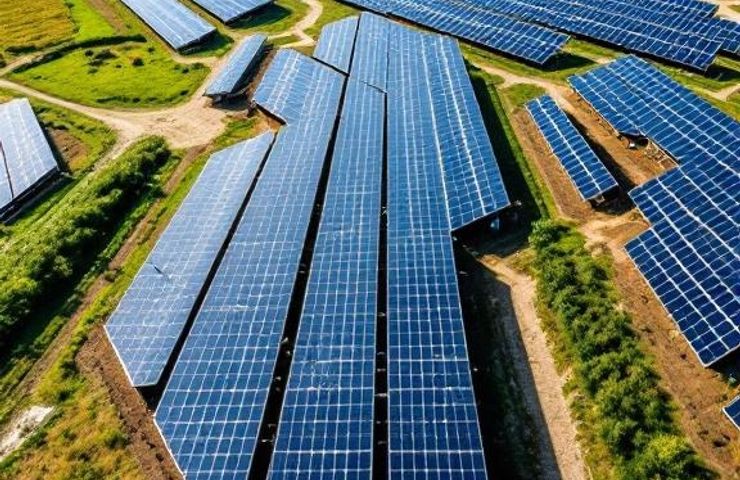
Belgium’s Solar Park To Produce Green Hydrogen From Sunlight using direct hydrogen-producing PV modules from Solhyd
November 12, 2025Belgium’s Solar-H2 First
In the rolling hills of Wallonia, near Namur, something pretty cool is about to happen in 2026. Ether Energy is gearing up to flip the switch on the world’s first full-scale solar park that blends a 2 MW PV farm with 50 kW of sun-powered, moisture-harvesting modules from Solhyd. And yes, it’s going live in the real world, not just a lab or pilot—you’ll get both juice for the grid and green hydrogen straight from the air and sunlight.
Core News
Spanning 10 ha, the site stitches together classic PV panels cranking out 2 MW of electricity and a lithium-ion battery system by SunBuild. Right alongside, 50 kW of specialized modules pluck moisture from the air and, when the sun’s shining, split water vapor into oxygen and hydrogen. Post-split, Nippon Gases swoops in to purify, pressurize, and ship the H₂ off to industries—steel, aviation, shipping, you name it. Operators can juggle between sending power to the grid, charging the batteries, or firing up the hydrogen production. That way, they dodge midday price crashes and turn excess sun hours into a marketable product. According to Solhyd, we’re looking at multiple tonnes of H₂ each year—a humble start, maybe, but a solid proof of concept for sustainable energy.
How the Modules Work
At the heart of each module are cylinders packed with a secret blend of sorbents and membranes. They passively grab humidity from the air, and once the sun heats them up, the water vapor splits into hydrogen and oxygen. The O₂ simply vents away, and the H₂ collects at low pressure—no need for liquid water sources, rare-earth catalysts, or massive grid hookups. Solhyd claims these modules rival small-scale PEM electrolysers in efficiency, cutting out extra conversion steps and making hydrogen production a lot less fussy to maintain.
Alternative Approaches
Most setups today marry PV arrays with standalone electrolysers, water treatment rigs, and compressors. Take Spain’s Extremadura plant: a 1 MW PV array feeding a 100 kW electrolyser. The direct-to-sun modules toss out those middlemen, promising a leaner footprint and simpler ops. But of course, you’re stuck with whatever conversion rate they’ve got—until they crank efficiency even higher, you’ve gotta play the hand you’re dealt.
Strategic Angle
This hybrid approach nails two big headaches: the sun’s ups and downs and grid bottlenecks. When electricity prices dive—sometimes even going negative—you can hit the hydrogen button instead. That means new revenue streams during cheap-power windows and a built-in hedge against those roller-coaster energy markets. It’s a neat fit for Belgium’s National Energy & Climate Plan, which aims for 1 GW of electrolysis by 2030 and helps fuel the EU’s 10-million-tonne renewable hydrogen goal. Plus, EU Innovation Fund grants and national subsidies are sweetening the pot, nudging developers toward these dual-output wonders.
Right now, green hydrogen from typical electrolyser routes costs north of €6 per kilogram. By folding solar generation and electrolysis into one, the direct modules could shave off €1–2—though the math is razor-thin. You’ll likely need top-tier off-take deals or hefty grid fees to tip the balance in your favor.
From Lab to Field
The tale kicks off at KU Leuven, where researchers cracked the code on water-vapor electrolysis more than ten years ago. Solhyd, a spin-off from the university, has been scaling up from bench experiments to rooftop demos and off-grid trials. The Namur park is its first commercial showdown. Early rooftop runs logged stable output over 1,000 hours, but let’s be honest—real-world weather can be a wildcard.
Every module will be hooked to IoT sensors tracking temperature, humidity, yield, and wear-and-tear. That data dump will be gold for investors sizing up longevity and performance. And let’s not forget Wallonia itself, once the coal and steel powerhouse of Belgium—now a research hotspot with 3.6 million residents, local universities, and businesses ready to snap up supply-chain and training gigs.
Collateral Impact
If this baby takes off, it could set a template across Europe: solar farms that moonlight as on-demand powerhouses, smoothing out peaks and staving off expensive grid upgrades. Industries hungry for decarbonization—steelmakers, airlines, shipping firms—get first dibs on on-site green hydrogen. Locally, we’re talking job creation in install crews, maintenance squads, and logistics ops.
It also plugs neatly into the European Hydrogen Backbone vision, where pipelines stitch production sites to major hubs. By co-locating hydrogen hubs with solar arrays, developers tap into existing land and grid hookups, delivering sustainable energy with fewer civil-works headaches. Some back-of-the-envelope estimates even suggest these setups could store energy for up to 10 days—though that claim could use an independent once-over before we call it a fact.
Maverick Take
Let’s cut to the chase: 50 kW of hydrogen is a drop in the bucket next to the gigawatt dreams out there. Scaling these widgets brings up questions about durability, efficiency drop-off, and the true all-in cost per kilogram of H₂. What happens in gray, overcast winters? Can operators juggle maintenance on both PV and hydrogen systems without losing their minds? Meanwhile, bigger electrolyser farms brag of economies of scale—though they also come with water treatment, buffer tanks, and intricate controls.
Still, the low-impact, retrofit-friendly vibe is a serious draw if you’re wrestling with grid curtailments. Utility co-ops, remote sites, even off-grid communities might look at these plug-and-play PV-to-H₂ modules and say, “Sign me up,” instead of getting bogged down in full-blown electrolyser plants.
What Comes Next?
I’ll be watching the run rates, capex vs. opex ratios, and seasonal data—ideally audited by a third party. Regulators might have to get creative with dual-output tariffs or hydrogen injection credits to push this beyond novelty status. If the EU’s hydrogen bank launches on time, that could unlock fresh financing.
Keep an eye on post-2026 market codes. If we see nodal pricing or molecule-backed certificates roll out, these dual-output sites stand to bank serious locational value. Germany and the Netherlands are tinkering with similar ideas, but nothing quite matches Belgium’s direct-to-sun spin. If this Belgian gamble pays off, expect a wave of hydrogen infrastructure sprouting across existing solar parks—ushering in a bold chapter for low-carbon power. If it flops, well, it might just end up as a neat footnote in the quest for ultra-efficient hydrogen storage.


 With over 15 years of reporting hydrogen news, we are your premier source for the latest updates and insights in hydrogen and renewable energy.
With over 15 years of reporting hydrogen news, we are your premier source for the latest updates and insights in hydrogen and renewable energy.